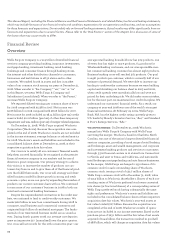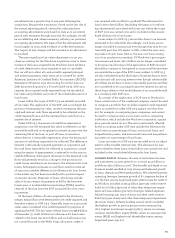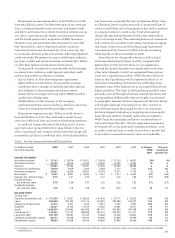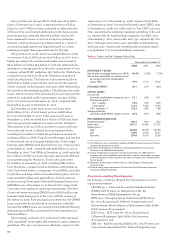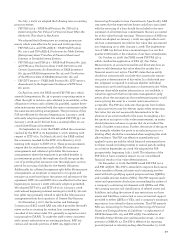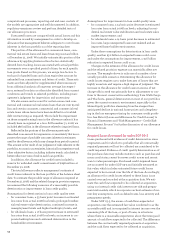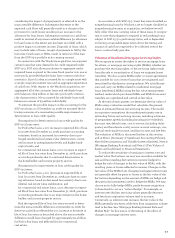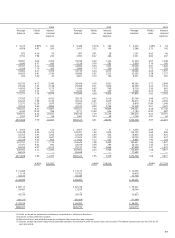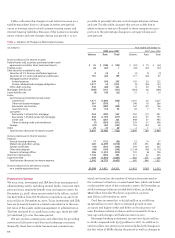Wells Fargo 2008 Annual Report Download - page 46
Download and view the complete annual report
Please find page 46 of the 2008 Wells Fargo annual report below. You can navigate through the pages in the report by either clicking on the pages listed below, or by using the keyword search tool below to find specific information within the annual report.Net servicing income, a component of mortgage banking
noninterest income, includes the changes from period to
period in fair value of both our residential MSRs and the
free-standing derivatives (economic hedges) used to hedge
our residential MSRs. Changes in the fair value of residential
MSRs from period to period result from (1) changes in the
valuation model inputs or assumptions (principally reflecting
changes in discount rates and prepayment speed assump-
tions, mostly due to changes in interest rates) and (2) other
changes, representing changes due to collection/realization
of expected cash flows.
We use a dynamic and sophisticated model to estimate
the value of our MSRs. The model is validated by an indepen-
dent internal model validation group operating in accordance
with Company policies. Senior management reviews all sig-
nificant assumptions quarterly. Mortgage loan prepayment
speed—a key assumption in the model—is the annual rate at
which borrowers are forecasted to repay their mortgage loan
principal. The discount rate used to determine the present
value of estimated future net servicing income—another key
assumption in the model—is the required rate of return
investors in the market would expect for an asset with similar
risk. To determine the discount rate, we consider the risk pre-
mium for uncertainties from servicing operations (e.g., possi-
ble changes in future servicing costs, ancillary income and
earnings on escrow accounts). Both assumptions can, and
generally will, change quarterly as market conditions and
interest rates change. For example, an increase in either the
prepayment speed or discount rate assumption results in a
decrease in the fair value of the MSRs, while a decrease in
either assumption would result in an increase in the fair value
of the MSRs. In recent years, there have been significant mar-
ket-driven fluctuations in loan prepayment speeds and the
discount rate. These fluctuations can be rapid and may be
significant in the future. Therefore, estimating prepayment
speeds within a range that market participants would use in
determining the fair value of MSRs requires significant man-
agement judgment.
These key economic assumptions and the sensitivity of
the fair value of MSRs to an immediate adverse change in
those assumptions are shown in Note 8 (Securitizations and
Variable Interest Entities) to Financial Statements.
Fair Valuation of Financial Instruments
We use fair value measurements to record fair value adjust-
ments to certain financial instruments and to determine fair
value disclosures. Trading assets, securities available for
sale, derivatives, prime residential mortgages held for sale
(MHFS), certain commercial loans held for sale (LHFS), prin-
cipal investments and securities sold but not yet purchased
(short sale liabilities) are recorded at fair value on a recurring
basis. Additionally, from time to time, we may be required to
record at fair value other assets on a nonrecurring basis, such
as nonprime residential and commercial MHFS, certain LHFS,
loans held for investment and certain other assets. These
nonrecurring fair value adjustments typically involve applica-
tion of lower-of-cost-or-market accounting or write-downs of
individual assets. Further, we include in Notes to Financial
Statements information about the extent to which fair value
is used to measure assets and liabilities, the valuation
methodologies used and its impact to earnings. Additionally,
for financial instruments not recorded at fair value we dis-
close the estimate of their fair value.
FAS 157, Fair Value Measurements (FAS 157), defines
fair value as the price that would be received to sell the
financial asset or paid to transfer the financial liability in
an orderly transaction between market participants at the
measurement date.
FAS 157 establishes a three-level hierarchy for disclosure
of assets and liabilities recorded at fair value. The classifica-
tion of assets and liabilities within the hierarchy is based on
whether the inputs to the valuation methodology used for
measurement are observable or unobservable. Observable
inputs reflect market-derived or market-based information
obtained from independent sources, while unobservable
inputs reflect our estimates about market data.
• Level 1 – Valuation is based upon quoted prices for identical
instruments traded in active markets. Level 1 instruments
include securities traded on active exchange markets, such
as the New York Stock Exchange, as well as U.S. Treasury
and other U.S. government securities that are traded by
dealers or brokers in active over-the-counter markets.
• Level 2 – Valuation is based upon quoted prices for similar
instruments in active markets, quoted prices for identical
or similar instruments in markets that are not active, and
model-based valuation techniques, such as matrix pricing,
for which all significant assumptions are observable in the
market. Level 2 instruments include securities traded in
less active dealer or broker markets and MHFS that are
valued based on prices for other mortgage whole loans
with similar characteristics.
• Level 3 – Valuation is generated from model-based tech-
niques that use significant assumptions not observable in
the market. These unobservable assumptions reflect our
own estimates of assumptions market participants would
use in pricing the asset or liability. Valuation techniques
include use of option pricing models, discounted cash flow
models and similar techniques.
In accordance with FAS 157, it is our policy to maximize
the use of observable inputs and minimize the use of unob-
servable inputs when developing fair value measurements.
When available, we use quoted market prices to measure fair
value. If market prices are not available, fair value measure-
ment is based upon models that use primarily market-based
or independently-sourced market parameters, including
interest rate yield curves, prepayment speeds, option volatili-
ties and currency rates. Most of our financial instruments use
either of the foregoing methodologies, collectively Level 1 and
Level 2 measurements, to determine fair value adjustments
recorded to our financial statements. However, in certain cases,
when market observable inputs for model-based valuation
techniques may not be readily available, we are required to
make judgments about assumptions market participants would
use in estimating the fair value of the financial instrument.


